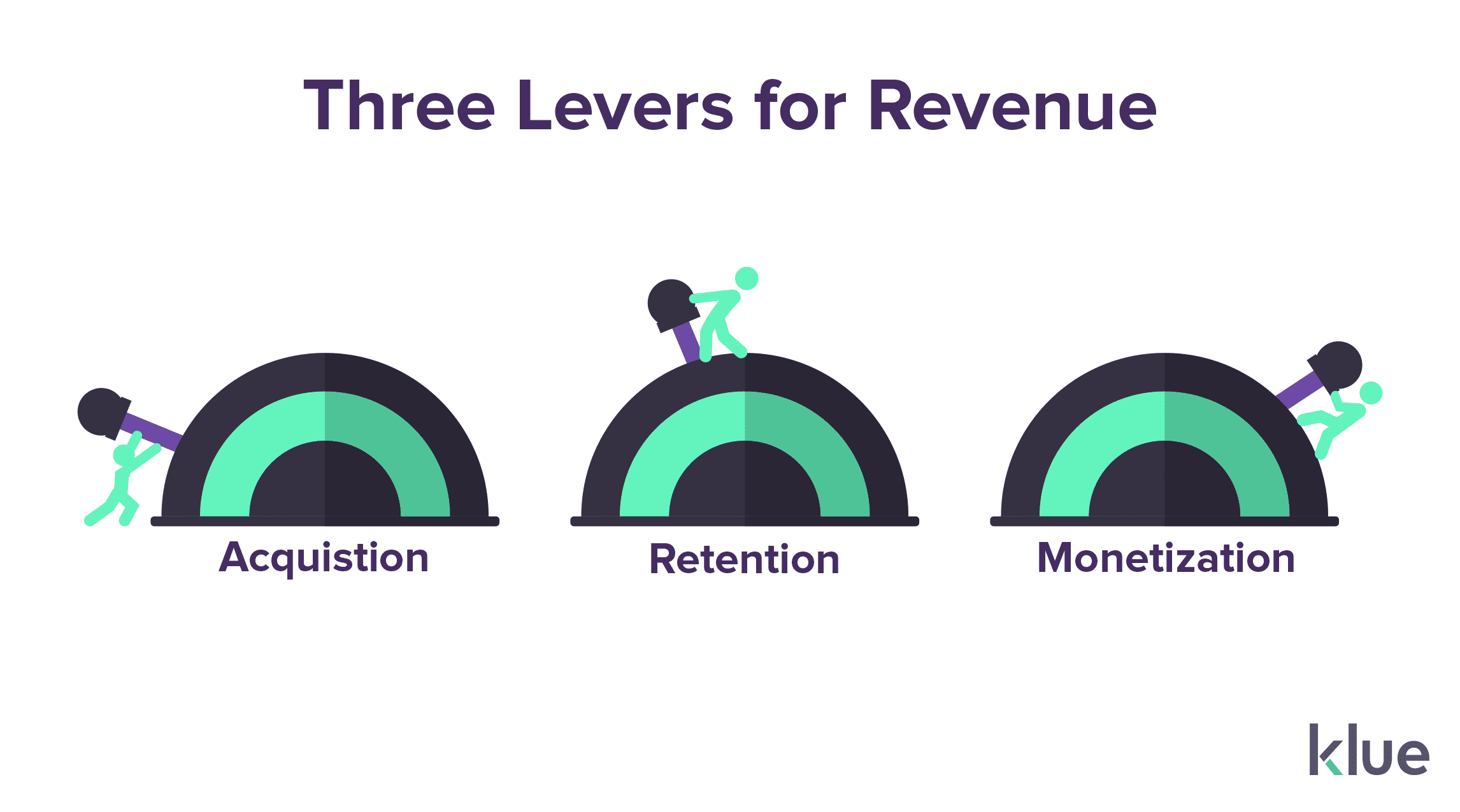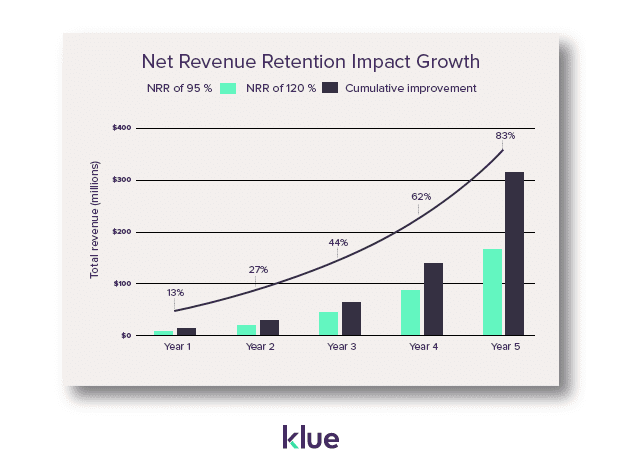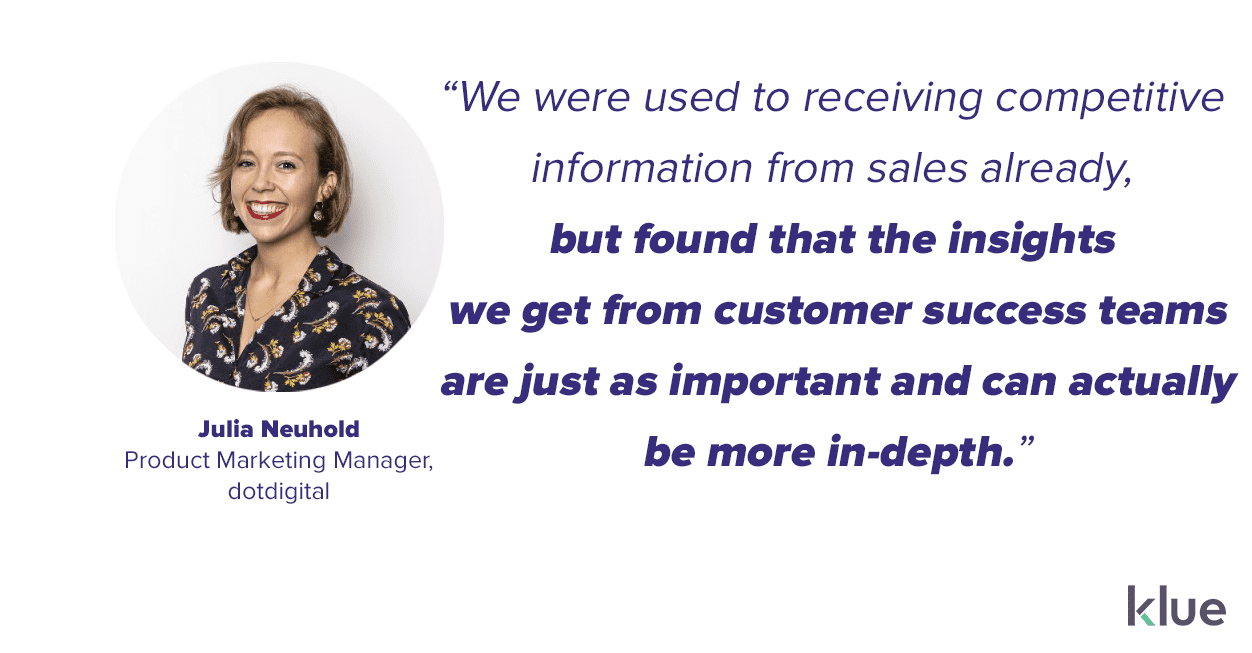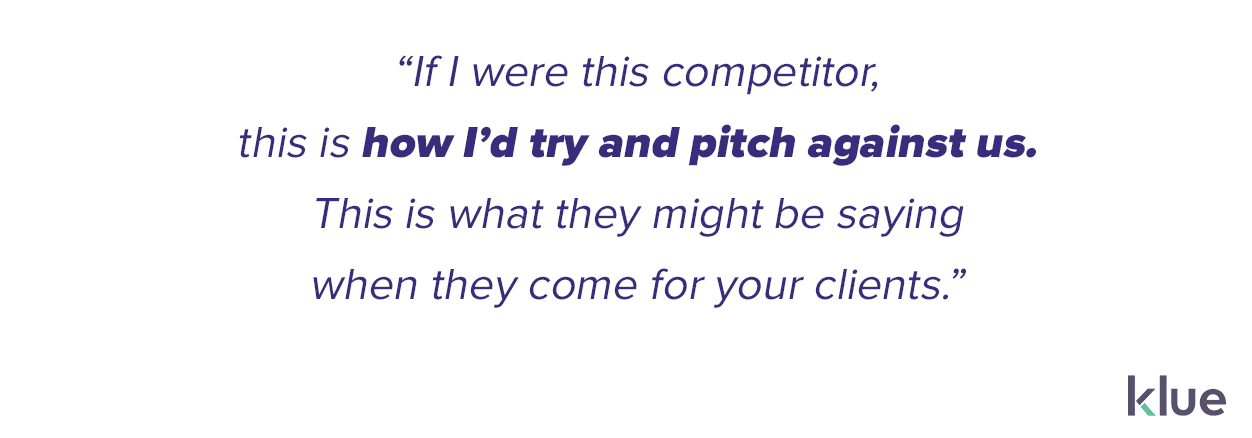Klue Compete
The Competitive Enablement Platform
Learn More
INTRODUCING KLUE INSIGHTS
FIND OUT MORE >

This article is part of our Klue series, where we share findings from the data in our Competitive Enablement Report.


The email above is not a message sent to a prospect by one of our own SDRs. It’s a real email that a competitor sent to one of our current customers in an attempt to steal them from under our noses.
Did they succeed? Nope.
Did that stop them from trying again another four times? Also, nope.
Competitors are attacking you from every direction, all day long. The threat doesn’t end once you close a deal.
And guess what we found when digging into the data from the Competitive Enablement Report? The entire org, including execs, expects their competitive programs to lead this fight to retain customers.
The only issue? CI pros and PMMs aren’t focusing on it… yet.
At face value, that may seem like a problem. But we optimists see it as an opportunity for competitive programs to impact revenue and prove their importance at the executive level.
So, your secret ingredient to competing this year?
Keeping (and then growing!) your customers.
During Gainsight’s most recent webinar breaking down the current state of customer success, Byron Deeter, Partner at Bessemer Venture Partners, said:
“Renewal rate is the single most powerful lever of all the financial levers and business and operational metrics for creating long-term value.”
We’ve talked about the fact that supporting sales teams with competitive intelligence to win new clients should be prioritized. But the battle for retaining customers can be equally as competitive and impactful to the bottom line.


Retention is one of the most critical revenue drivers for businesses, particularly for those that are experiencing high-growth in competitive industries. Let’s look at a quick example of its financial impact on your company’s revenue.
Two companies are both entering 2021 with $6 million in Annual Recurring Revenue (ARR). Over the next five years, they both maintain 100% growth of new revenue.
The only difference? Company A has a Net Retention Revenue (NRR) of 95%, while Company B has an NRR of 120%.
Here’s how their financial picture fares over five years:


Company B will outperform Company A by 83%. That equates to $140 million.


Yes, we all get excited about something new. That’s the nature of the game when acquiring new customers. But retaining and growing existing accounts plays an equally large role in determining the long-term financial growth of a company.
Preventing customer churn has become an increasingly important part of business strategy in the ‘new normal’.
The customer mindset has shifted – budget constraints limit what they’ll buy and bring a lot more scrutiny to the table when deciding on renewing a product or subscription.
Frankly, the fight to build and retain loyal customers has become even more competitive during a global pandemic. Results from our report show that competitive programs are over seven times more likely to have grown in importance to their company because of the effects of COVID-19.


The barrier for customers to leave has shrunk, and the risk of increased churn can crush your revenue growth. Adam Houghton, VP of Success at Klue, explains:
“If you’ve spent all of this money to acquire new business, then you have to keep them as a customer for one to three years. You should be investing just as much, if not more, on the retention side, because 80 to 90 percent of the revenue you’re going to get from the lifetime of any customer is after the first purchase.”


The data from our report agrees that executives are strategically focusing on retention, and want their competitive programs to help them achieve this.
When asked what the primary benefit a comprehensive competitive enablement program should bring to the business, executives noted that increased customer retention was the most important expected benefit.


“There’s this shift that’s happening in some forward-looking companies. This nuance where companies are going from sales enablement to revenue enablement, and competitive is definitely a part of that,” Adam explains.
But, here’s the issue.
Despite becoming more important to the organization during the pandemic and executives expressing a desire to improve retention, Competitive teams haven’t seen this opportunity yet.
Results from the report indicate that competitive teams believe they should be primarily serving executives with strategic insights. Improving retention didn’t even crack their top five benefits.


In case you’re craving a little bit of irony, the executives themselves don’t care nearly as much as being served with strategic insights, rating that benefit as fifth most important.
High-level strategic support for execs is just table stakes; the real value of your competitive enablement program is when it impacts revenue.
Okay, so we’ve established that retaining customers is financially critical to the business and that execs want to prioritize improving it in the new year.
It seems as if the stars are aligning for your competitive program to make a preeetty big impact on revenue… What’s that? Music to our ears?
But as we can see in the report, enabling customer success teams and improving retention hasn’t been something that traditional competitive programs have focused on.
So, how do you go about doing it, and more importantly, doing it well?
We spoke with Julia Neuhold, Product Marketing Manager at dotdigital, to learn more about what enabling customer success teams with competitive intelligence actually looks like.
When they brought the customer success team into their competitive enablement program, they noticed three particular benefits:
Competitive programs typically lean on their win-loss interviews and intel that sales hear in the field as a huge source of competitive intelligence. But dotdigital recognized that customer stories and feedback could be an equally critical source of information for the entire company.
“We were used to receiving competitive information from sales already, but found that the insights we get from customer success teams are just as important and can actually be more in-depth, really helping everyone. Plus, having fostered a positive two-way relationship with them meant they were accustomed to sharing information, so it came about very easily,” said Julia.


Customer stories can provide some of the most valuable competitive insights for the entire company; while win-loss information is a good way to understand how a prospect perceived the value of your product, a customer story provides insight as to what makes a happy customer tick – or even what experiences might drive them to consider alternative options.
The customer success team was able to centralize these stories and find the common storylines that their competitors go after. It becomes a live feedback loop that builds up their knowledge and benefits everyone involved.
Clients also build the deepest relationships with customer success teams. When they reach a certain level of trust, customers will more openly share when a competitor is approaching them and what they’re saying. (See the email we shared at the start of this blog!)
Just a little more ammunition for the entire org.
Although dotdigital’s customer success team quickly took to collaborating and sharing meaningful competitive intel, they still weren’t as well-versed in actually using the intelligence to their advantage in competitive situations.
It was only the sales team who were familiar with applying the competitive content.
“With sales, competitive intelligence is more of an active topic. Those are the people that you talk with about competitors all of the time. It’s just more front-of-mind with them,” Julia explains.
Whereas for other teams, it will have only been on an ad hoc basis. A client might mention a competitor out of the blue, that’s when they need the information at hand.”
With their customer success team now getting a clearer understanding of their competitors, dotdigital decided to bring their sales leaders in to help the customer success team use this intel to pitch against competitors during renewals and as a part of their initiative to future-proof clients.
“Our sales leader basically said ‘you’ve never had to pitch dotdigital, so why would you know how to? Let me show you how I would do it.’”
“They also took a different angle and explained ‘if I were this competitor, this is how I’d try and pitch against us. This is what they might be saying when they try and come for your clients.’”


During these meetings, Julia noticed that the sales team and the customer success team had previously talked very differently about their product, their features, and the company.
“Bringing these two teams together and having that exchange… they found that so interesting and useful.”
3. Future-proofing clients proactively against their competitors
It’s all well and good for your sales teams who are in the heat of battle during a competitive deal. They know that they’re up against someone, and their guard is up.
For customer success, it can be a bit different. Julia recommends focusing on future-proofing clients proactively against competitor advances and claims.
Given that it’s hard to know when a competitor will go after your customers, dotdigital decided that the best course of action was to control the variable that they could control. They trained their customer success team to proactively future-proof their clients about what they knew their competitor would inevitably say.
“We created content around future-proofing clients. We use Klue to explain competitor’s sales strategies when approaching existing clients. Then we broke down how to prepare for them and how to then deposition that competitor.”


A critical part of any business in the SaaS industry is to make sure customers are getting the most out of your platform. So strategies around driving feature adoption with clients are crucial.
Because the customer success team became more familiar with their competitors, and sales had helped coach to spot and pitch against them, the team was equipped to steer clients in the right direction, even when difficult questions were being asked of them.
Investing in the soft skills for your customer success teams isn’t enough anymore, and executives are recognizing this.
Just like in a pre-sales environment, customer success teams are having to handle objections regularly. Their customers are being called by competitors all day long.
Top-performing businesses already know the importance of retaining customers to the financial growth of the company – but the ‘new normal’ shined an even brighter light on its significance.
While competitive programs are rightly focused on enabling sales to acquire new customers, they can also be used to enable the teams that are dedicated to keeping and growing these clients.
(For more information on building a winning competitive program, make sure to check out our Competitive Enablement Report.)


Competitive Enablement
The topic of Large Language Models (LLMs) has a lot of confusion. Here's what you need to know about how Klue is working with them.


Competitive Enablement
Product Marketing
If your competitive intel game is too strong for automation, too pure for data privacy, and too rebellious for accuracy — then Klue AI is probably not for you.


Let’s do it. Tell us a bit about yourself and we’ll set up a time to wow you.
Let's do it. Tell us a bit about yourself and we'll set up a time to wow you.
XLet's do it. Tell us a bit about yourself and we'll set up a time to wow you.
XSubscribe to get our latest AI functionality and news in your inbox.
XOur Buyer Pulse feature, set to launch in Q2 2024, offers valuable insights into the factors influencing buyer decisions in your pipeline. By signing up for the waitlist, we can better gauge interest and proactively engage with you to streamline the setup and integration process before the feature becomes widely available.
X